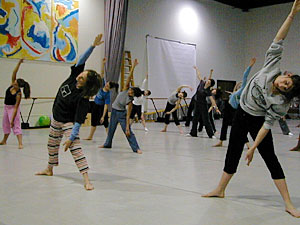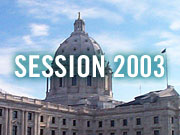Photos
Your Voice
| |||||||||||||||||||||||||||||||||||||||||||||
State cuts threaten arts high school's mission
April 18, 2003
 |
| Students stretch their muscles in the dance studio at the Perpich Center for the Arts. (MPR Photo/Tim Pugmire) |
Golden Valley, Minn. — The late Gov. Rudy Perpich proposed an arts high school for Minnesota in 1984 after visiting New York City's High School for the Performing Arts. That's the school that inspired the movie "Fame." The plan had its share of critics. But the state-run residential school is now in its 14th year, training students from every part of Minnesota.
Students stretch their muscles in the dance studio at the Perpich Center for the Arts. A guest choreographer leads the warm up exercise while the dance class instructor plays the piano. Senior Breanna Noyce is in her second year studying dance at the arts high school. She lives in the residence hall. Her home is 270 miles away in Grand Marais.
"I had known people who had gone here, and I was very involved in dance," Noyce said. "I had felt like I needed to go somewhere else than where I was dancing. I miss like all my friends, but I still go home once an a while."
Noyce is among 300 students enrolled in the tuition-free school. Admission is competitive. Students study dance, literary arts, media arts, music, theater or visual arts. David Flannery, the center's interim executive director, says about 65 percent of the students are from the metropolitan area. The rest come from cities throughout Minnesota.
"One of the strengths of this school has been this mix of kids from rural areas, from small towns and from large cities," Flannery said. "And to have them here together, you know a small group of them, 300 together going to school, creating, doing. It's a real powerful experience for them. And we want to keep that mix, and we want to increase the mix."
 | |||
But cuts in state funding could make it much harder for the school to serve its traditional mix of students. Governor Pawlenty's budget preserves current funding levels for public elementary and secondary schools. It cuts funding to state agencies, including a 15 percent hit on the Perpich Center over two years. That cut follows similar funding reductions the past two years. Flannery says most of the cut will be felt in the center's outreach programs. He says the arts high school can only absorb a five percent reduction.
"Cutting beyond 10 percent in the high school, you have to talk about closing the residence, closing the dorm, Flannery said. "Well, if you close the dorm, you change the mission of the organization. Right now we're designed to serve the state of Minnesota. We cannot serve kids from all over the state if we don't have a residential program."
Flannery says money from a McKnight Foundation grant is helping the center weather its current budget problems.
Layoffs have been kept to a minimum. But maintenance and repairs on the center's five buildings will be delayed. And the center's other functions are getting scaled back. The Perpich Center provides training and resources to art teachers and schools throughout the state. It serves as a laboratory for arts instruction.
Kathleen Maloney, executive director of the Minnesota Alliance for Arts Education, says she's concerned about the larger impact of the budget cuts. "What comes out of there in terms of new thinking and research, and it's all based on the work that they do with Minnesota schools and Minnesota kids," Maloney said. "We are the envy of arts education people around the country for having that resource."
|
It is an expensive program, and we provide a lot of support to the kids.
- Rep. Alice Seagren, R-Bloomington |
A key legislative leader is trying to save the Perpich Center's funding and its statewide mission. Sen. Leroy Stumpf, DFL-Thief River Falls, chairman of the Senate Education Finance Division, says the DFL Senate budget will maintain current funding commitments.
"Funding would stay fairly flat, but we would not make those deep cuts in the Perpich Center," Stumpf said. "I think, I frankly think the Perpich Center would have to change a significant amount of their focus and would have a big impact on their budget if the governor's budget actually passed."
Republican leaders in the Minnesota House are going along with the governor's proposal. Rep. Alice Seagren, R-Bloomington, is chairwoman of the House K-12 Finance Committee. She says the Perpich Center is currently spending $11 thousand annually on each of its students. That's significantly more than most Minnesota school districts. "It is an expensive program, and we provide a lot of support to the kids," Seagren said. "And I think to the extent that they have to maybe tighten their belt and reflect more of a traditional student, I think that's all right to do that."
David Flannery says there are reasons why the school is expensive. He says one big factor is the cost of operating a dormitory and food service for students living on a 22 acre campus. He says the Perpich Center is a small school at 300 students, but it still must provide many of the services available in large public high schools. Flannery says the school must also provide a distinctive academic program.
"Because we are a magnet school, we have to offer more than they can get at Wayzata High School, or somewhere else, if we're going to attract kids," Flannery said. "Or if not more, different. And so we are more expensive."
Flannery says he's trying to cut back on the school's operational costs and per pupil spending. He's also looking for new revenue sources for the school. The Perpich Center will reactivate its foundation in the coming weeks. School officials will begin seeking donations from more than 1,600 alumni.
|
News Headlines
|
Related Subjects
|

